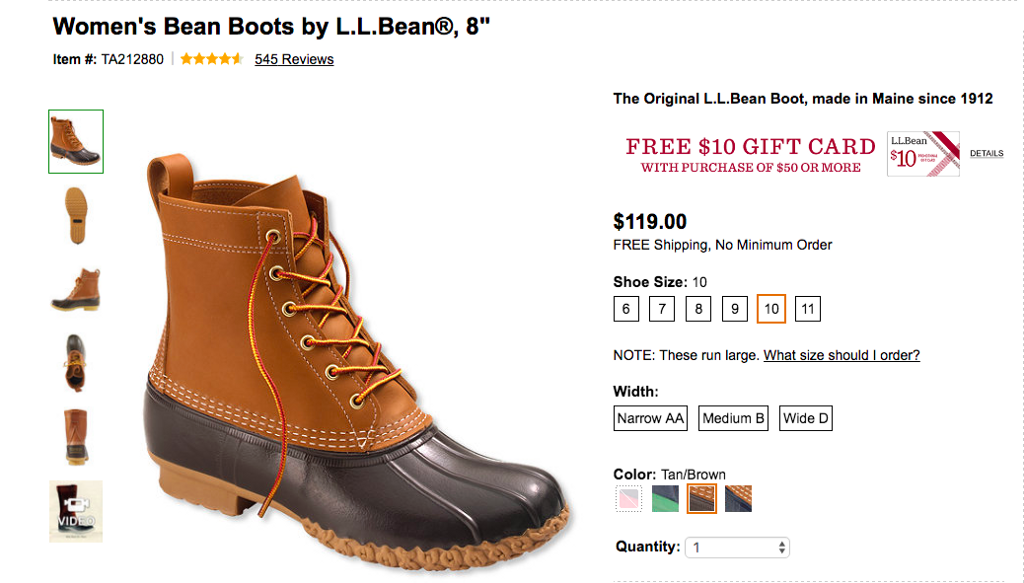The Aspirational Nostalgia of the L.L. Bean Boot
For once, they’re not backordered.

Every year, in that jiggly last week of November, I love nothing more than tracking the state of the L.L. Bean Boot and whether or not they’re still available for order. This petty concern is probably related to my desire for a pair of said boots which goes hand in hand with my desire to revamp my wardrobe every winter. I have sweaters and cold weather things; I’ve lived in a city with sort-of discernible seasons for almost seven years. I have a pair of snow boots, heavy duty Sorels that work great for the occasional blizzards and their attendant ankle-deep puddles of slush. But the Bean Boots’s allure is strong. The trouble is, for the past three years, these boots have been backordered by at least September.
In 2014, the boots were backordered by the first week of December. In 2015, L.L. Bean hired 100 extra boot makers and were still unable to keep their most popular models in stock. This year, spurred by a Cyber Monday listicle and the feverish mental state that comes with forgetting to eat lunch, I briefly perused the site and noted with great pleasure that the L.L. Bean Boots of my dreams were somehow, magically still in stock.
According to the Boston Globe, the one publication that reports on this yearly phenomenon with the gravity it deserves, the Bean Boot’s continued ascendancy is all a part of the nostalgia cycle, attributing their astronomical surge in popularity to things like Urban Outfitters selling Stanley thermoses and record players — classics purchased by millenials who have no real shared memory of these objects in their everyday life.
Nostalgic customers still seeking out LL Bean’s ol’ boots
L.L. Bean Boots tie in nicely with that aesthetic, but they’re also a marker of a very specific New England WASPiness that I still find the teensiest bit alluring, regardless of how loath I am to admit it. Sure, they’re boots that are still made in the U.S.A. and, from what I hear, they do a good job of keeping your feet warm and dry when it is the opposite outside. They’re also the shoe of choice for people interested in looking like they hack about the woods on Thanksgiving morning with their ruddy-cheeked family in the Berkshires. They are an object that for me, denotes a certain class — old-monied, white and with a comprehensive understanding of how to crack a lobster without sacrificing any of the meat in the tail. They’re boots for people with second homes deep in the snowy woods, meant to be piled in the corner of a mudroom with damp wool Ragg socks laid out to dry on the vents of the heater.
I’m not against the boots, but I recognize that for me, what they represent is a kind of life that I haven’t led; they’re aspirational at their essence, a means of keeping my feet warm, yes, but also a silent signifier of the kind of life I want people to think I lead. Everything we wear speaks to this desire; some items get their point across much louder than others.
They’re hand-sewn in Maine. They sell out every year. The hype surrounding them ratchets up the demand. They’re boots meant for whacking about the field just beyond the old stone wall while wearing a vest and carrying a mug of something hot and bracingly alcoholic, like a modern day Lord Grantham but in Vermont instead of England. And people can’t get enough.
I probably won’t buy Bean boots this year, only because I’ve been considering it for so long that the thought of breaking them in is far too rich for my blood. Besides, I have snow boots. I’ve had them for years and they work just fine.
Support The Billfold
The Billfold continues to exist thanks to support from our readers. Help us continue to do our work by making a monthly pledge on Patreon or a one-time-only contribution through PayPal.
Comments